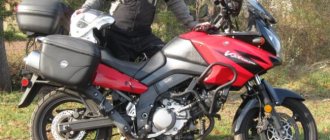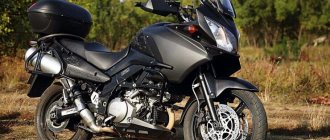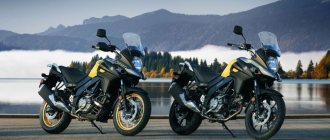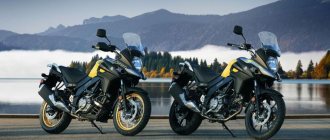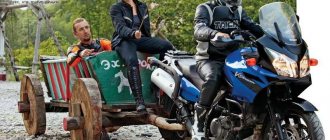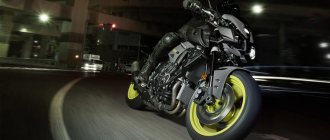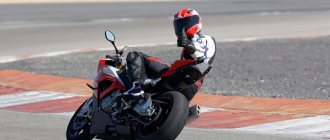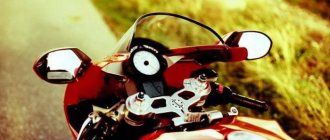The popularity of touring enduros has grown greatly since the appearance of the first bold serial experiments on rally-raid mastodons in the late 80s. Initially, tourenduros were for a long time considered a technique for a narrow circle of consumers. The Suzuki V-Strom family managed to jump into the departing carriage, standing on a par with the elders of the genre. Despite the lack of a motorcycle racing history as such, the Streams, thanks to their distinctly isolated focus on long asphalt runs and ease of everyday use, have acquired a good reputation and are still in price.
First generation (2002–2011)
The “construction” was started practically from scratch. The Japanese engineers' previous experience with big rogues was the bone-crushing DR800. The tech cocktail with the DL1000 index turned out to be quite explosive: in an aluminum frame of the original design with a removable aluminum rear subframe, a V-shaped twin borrowed from Suzuki TL sportbikes was installed with four valves per cylinder, an SDTV system (two rows of throttle valves), an injection power system, and chains in the mechanism valve timing, liquid cooling and a six-speed gearbox. The power unit was “squeezed” to 98 hp. With. at 7400 rpm and 101 Nm at 6400 rpm to get more thrust at low and mid speeds. Some kinship with sports motorcycles allowed Suzuki to quite reasonably designate the Suzuki V-Strom as a “sport enduro tourer” according to its internal classification. The first “liters” went on sale in 2002.
The appearance of the V-Strom is one of the most memorable... Suzuki usually doesn’t do it any other way! A large number of plastic parts deliberately create many edges and sharp corners. The double headlight, which occupies the entire front part of the motorcycle, adds impressiveness and solidity to the image.
The Suzuki DL1000 V-Strom suspensions are close to their purely road counterparts. The front part uses a telescopic fork with a stay diameter of 43 mm, a stroke of 160 mm and adjustable preload; at the rear there is a monoshock absorber with a stroke of 162 mm, adjustable spring preload and rebound damping. The ground clearance in fact turned out to be quite small. Therefore, it will not be possible to climb particularly far into the pampas, even if you want to. The braking system used on all first-generation motorcycles is not particularly progressive. Twin-piston calipers with 310 mm discs at the front and single-piston calipers with 260 mm discs at the rear work to the limit. Installing reinforced lines and “evil” pads on a newly purchased motorcycle is a normal practice for a “steer guide”.
In the 2000s, as a result of the partnership between Suzuki and Kawasaki, not only Intruder/Vulcan choppers were introduced, but also touring enduros. A complete analogue of the Litroström from Kawasaki is called Kawasaki KLV1000. The motorcycle was produced from 2004 to 2006. It differs from the prototype only in name.
In 2003, the DL1000 V-Strom receives a modified clutch basket and seat with a new, more comfortable profile, the front fork has the ability to adjust the spring preload, and the generator power increases from 350 to 400 W. Another year later, in 2004, in parallel with the transition of the ECU from 16 bits to 32 bits, a small liquid crystal screen appears in the instrument panel, the design of the windshield is complemented by a simple height adjustment mechanism, mirrors are also updated, wind protection for hands (becomes tougher due to fastening at two points ) and direction indicators. At the same time, the engineers reconfigured the gearbox, modified the gear shift mechanism and added an emergency light to the left control panel. To gain some ground clearance, from 2004 all DL1000s have been fitted with a plastic engine guard with a flatter bottom edge. That same year, a new branding style of plastic decals was distributed across the entire Suzuki range, including the V-Strom. The flat “Suzuki” inscription is replaced by a convex letter “S”. Since 2005, the frame color changes from silver to black, and the head light turns on automatically. Since 2006, more efficient oil injectors have been installed in the engine. In the same year, the manufacturer solved the problem of the clutch release cylinder by forcibly installing a boot on it. Subsequently, the modernized parts were added to the catalog for all years of production of the “liter”. In 2007, the direction indicator glasses were replaced with transparent ones.
Production of the first generation DL1000 V-Strom ceased in 2007, but sales continued in some countries until 2011.
002_moto_0311_036
2004 - DL650 V-Strom.
2004 - DL650 V-Strom.
WHERE TO LOOK? Suzuki's pricing policy for the DL series is more than humane. “Ve-Stroms” are generally considered one of the most budget options among their peers, and given the fact that the model is quite recent and has been sold by both officials and gray dealers since the very first year of production, now the largest number of offers on the secondary market are marked “ with mileage only in the Russian Federation.” This is a rather atypical situation for Russia, because most motorcycles of any class, displacement and price category nevertheless began their road “life” behind the cordon. And you shouldn’t be afraid of the “Strems” who have “lived” their whole lives in Russia. This motorcycle is rarely bought as a first, and due to its road-tourist orientation, it is rarely interested in both racers who are capable of quickly and efficiently destroying equipment, and serious endurists who have the same abilities, but not because of a bad head, but because of the harsh operating conditions in the most distant bearish corners. Moreover, much more often than any other motorcycle, you can find a not very young V-Strom with a ridiculous mileage of several thousand km. People over forty often choose this motorcycle, but the biker in them is never born again.
The price range for the “junior Strom” ranges from 200 thousand rubles. for motorcycles of the first years of production, and up to 400 thousand for copies of “this year”, which is very close to the retail prices for new devices in showrooms, so there is no particular economic sense in buying a 1-2 year old motorcycle.
There shouldn’t be any problems with selling the Strom, although, of course, the demand for it, especially taking into account the “lithromania” that is not abating in our country, is noticeably lower than for louder models and fluctuates throughout the year. Nevertheless, the Strom will definitely not lie as a dead weight in the garage, and it will find its buyer quickly enough, and given the rate at which the popularity of this class of motorcycles is growing in Russia, we can only predict an increase in demand in the coming years.
Second generation (2013 – present)
Suzuki DL1000 V-Strom in 2013 was resurrected like a phoenix. Moreover, in a new interpretation. The motorcycle, with unchanged fundamental technical solutions, has changed in almost every detail. Of course, the first thing that catches your eye is the appearance. “Ström” is beautiful, but not as recognizable as before. This is due to the transition from two separate headlights to one medium-sized oval one a la Suzuki GSX-R, from which a very funny sharp bird's beak rushes forward. The amount of plastic on the motorcycle has been radically reduced. Thus, the silhouette was cut into separate parts - the tail was released, due to the fact that the exhaust “can” moved downwards, the tubular rear subframe became visible. According to Suzuki designers, when creating the image of the new “liter”, they took inspiration from the old Suzuki DR750S from 1988.
The frame is still an aluminum diagonal structure. But now it is already in the middle part and 13% lighter. The new two-cylinder engine with a 90° cylinder angle, liquid cooling, two spark plugs with individual coils (the system appeared only in the second generation) and four valves per cylinder has gained a little meat compared to its predecessor. The working volume increased to 1037 cm3, peak power increased to 100 hp. With. at 8000 rpm, the electronics settings and the ignition system have changed. The oil cooler in the cooling system had to be sacrificed to reduce weight without compromising performance. The volume of the fuel tank was reduced to 20 liters. The range of electronic assistants has expanded significantly. Electronic two-level traction control was added to the already existing ABS system (for the first time on Suzuki motorcycles). The Ride-by-wire system, which is already standard on modern motorcycles, is not available on the 2014–2016 DL1000. The Japanese remained faithful to the dual throttle system, adding more efficient injectors to it. The first row of dampers is controlled through cables by the throttle handle, the second row is controlled by an electronic unit through a servo drive. An electronically controlled boost valve (ECM) has been added to the exhaust system. The clutch is still hydraulically driven and has a superstructure in the form of a SCAS (Suzuki Clutch Assist System) control system. The sixth stage in the gearbox has become much longer.
The engineers stuffed the suspension of the new “liter” with all the necessary adjustments as much as possible, due to the lack of Suzuki electronic systems that allow you to change settings on the fly, and did not forget about modern trends. That is why the second generation motorcycle is equipped with an impressive fully adjustable Kayaba “upside-down” with a 43 mm diameter of stays and a modern monoshock absorber on progression links with rebound adjustment and preload adjustment located on a separate large “twist”. The rear aluminum swingarm is lengthened by 26 mm (base 1555 mm), the fork rake is reduced to 25°. With a similar chassis geometry, the motorcycle turned out to be very nimble and obedient.
The braking system is also a local revolution. The long-awaited Tokico four-piston radials are mounted on the front wheel along with 310 mm discs. At the rear, as before, there is a single-piston Nissin caliper and a 260 mm disc. An anti-lock braking system using Bosh components is part of the standard equipment. The wheel sizes are the same – 110/80–19 and 150/70–17.
Nice additions include an adjustable windshield in height and angle (six possible positions in total), a 12 V socket and a dashboard with an on-board computer and a gear indicator.
004_moto_0311_036
Although the oil radiator is equipped with a protective mesh, it has a chance of getting hit by a stone from under its own wheel.
Another argument in favor of crankcase protection. The exhaust pipe of the front cylinder is the lowest point of the “underbelly”, which means it will be the first to suffer from stones and snags in off-road if it is not covered with protection. “Strom”, as an “honest” crossover, gravitates towards asphalt components. The gearbox and brake pedals are cast from brittle aluminum, which means they can easily break if dropped. Although the oil radiator is equipped with a protective mesh, it has a chance of getting hit by a stone from under its own wheel. Another argument in favor of crankcase protection. The exhaust pipe of the front cylinder is the lowest point of the “underbelly”, which means it will be the first to suffer from stones and snags in off-road if it is not covered with protection. “Strom”, as an “honest” crossover, gravitates towards asphalt components. The gearbox and brake pedals are cast from brittle aluminum, which means they can easily break if dropped.
First generation (2004–2011)
A smaller copy of the flagship liter launched with a two-year delay in 2004. The power unit is a redesigned and almost not deformed (loss of only 3 hp) version of the “two” from the SV650. The main design differences from the “liter” are in the displacement, camshafts, crankshaft with inertia increased by 4%, filter box and exhaust design. The working surface of the cylinders, as in the case of the DL1000, is coated with a patented SCEM composition based on nickel, phosphorus, carbide and silicon. This coating has similar characteristics to nikasil. In the donor SV-hi engine, cast iron liners were used. The power system, similar to its older brother, uses two rows of throttle valves. The cooling system is tied to two radiators.
What is characteristic is that the “650” is absolutely not inferior to the “liter” in terms of tactical and technical characteristics. Quite the contrary. With similar dynamics, the DL650 is much more interesting in terms of maneuverability and fuel consumption (4–7 liters in city mode versus 8–12 liters for the DL1000). However, with maximum load on the 650, there is no power reserve of 140–150 km/h at all. “Pushing” the device over 150 km/h becomes an impossible task. The liter version overcomes these difficulties in one go.
If we think in big pictures, then from a distance the “650” clearly differs from the “liter” in one “can” of the exhaust system on the right side (the DL1000 has two of them), the absence of a plastic plow under the engine, the absence of gills on the side plastic in the area of the engine and protective mugs on the steering wheel, as well as nameplates and some small parts. Otherwise, the first generation motorcycles are indistinguishable.
As part of the first generation, the V-Strom 650 was gradually modernized throughout its eight years. So in 2005, the head light began to turn on automatically after turning the ignition key. In 2007, an anti-lock brake system appeared on the list of options, the engine received an ignition system with two spark plugs for each cylinder, and the wheelbase increased to 1560 mm due to an increase in the length of the pendulum by 15 mm. In the same year, the idle air control screw was abolished in the intake system in favor of electronics. In 2008, the generator power was increased from 375 W to 400 W. Throughout 2010, the Suzuki V-Strom 650 was not sold in the US market. In 2011, sales resumed, and ABS became part of the standard equipment.
The 650 is largely a copy of its liter counterpart. The only differences are in the engine, electronics, attachments and suspension presets. An important feature of the DL650 is its absolutely problem-free (which cannot be said about the DL1000) cable clutch drive.
003_moto_0311_036
The V-Strom family became the founder of the "parquet" enduro class for touring.
The V-Strom family became the founder of the "parquet" enduro class for touring.
WHAT TO WATCH FIRST AND WHAT TO FOLLOW LATER?
(—) Clutch basket rattling. A problem common to both “strems”. A roar that is heard at idle and disappears or noticeably subsides when the clutch is depressed indicates wear of the basket bearing and its seat. In particularly “neglected” cases, the noise can be heard even while driving. This defect has several causes. Firstly, there is a design defect - the unit is clearly weak. Secondly, this may indicate the use of low-quality oil or untimely replacement, especially if the motorcycle’s mileage is low. And thirdly, this indirectly indicates the aggressive driving style of the previous owners. However, you need to remember that sooner or later, the basket begins to rattle on all V-Stroms, and when choosing a motorcycle, this can only be an argument for lowering the price, because the defect can only be cured by replacing the basket, which, together with the work, results in approximately 17-20 thousand. rub. If the rattling basket is not replaced in time, the loose unit will break the bearing seat, and the cost of replacing the crankcase is already comparable to the cost of another “stroke”.
(-) Difficult cold start, low or floating idle, interruptions in engine operation, sluggish response to gas, decreased maximum speed and acceleration dynamics. If a motorcycle exhibits these symptoms, this does not mean that the Khan’s engine needs to be abandoned. Most likely, the fuel inlet strainer of the fuel pump is clogged. This “disease” is inherent in both the “650” and the “liter” and can affect motorcycles even with a mileage of 8–12 thousand km, not to mention veterans. You can make sure that the problem is a clogged fuel receiver by measuring the compression in the cylinders, and if this parameter is normal (10–11 kgf/cm2), check the pressure in the fuel line. The fuel pump should “blow” 2 atmospheres. If it is less, you need to clean it. The fuel pumps themselves are quite durable and rarely fail, and cleaning the pump mesh and injectors at a motorcycle service center will cost about 3-5 thousand rubles. The only sad thing is that there are no methods to prevent this disease. It is impossible to equip a submersible pump with any kind of pre-filter, and the fuel intake screen has to be cleaned on average every 15–25 thousand km, which depends on the quality of the gasoline.
(-) "Dead" starter. A problem directly related to the one described above may be hidden in the button contacts. Due to poor engine starting caused by a clogged fuel pump, as a result of numerous and long “torments” of the starter, the contacts of the button, which not only turn on the electric motor, but also open the head light circuit, burn out.
The problem is diagnosed by ringing the circuit, and is most often eliminated by cleaning the contacts.
Another reason for a “silent” starter button is a malfunction of the clutch release sensor located on the lever, because the electrical system allows you to start the starter only with the clutch depressed.
(-) "Thin bone." The common name for several “sores” speaks for itself. The motorcycle is very sensitive to impacts. First of all, both when choosing a motorcycle and during its operation, you need to pay attention to the wheels. Even a minor pothole in the asphalt, coupled with a completely “peaceful” speed of 60–70 km/h, can make a serious dent in a cast rim, or even crack it. It is also worth remembering that rolling a disc with a seemingly insignificant dent can lead to cracks, so even slight deformation of the rims can be a reason for significant bargaining or refusal to purchase, especially since, due to the standard nature of the disease, it is difficult to find “used” wheels almost impossible.
The steering wheel is equally defenseless. Often the handlebar tube bends even from a seemingly harmless fall of the motorcycle from the stand, not to mention more serious “flights”. In principle, a flimsy pipe can be straightened back without much effort even without a tool, but it is better to replace it with some analogue with a stronger “character”.
Another weak point is the “spider” on which the “muzzle” is assembled. The front of the motorcycle warps even from slight falls. Too much weight hangs on the unreasonably openwork part, so the “distorted muzzle” is a reason to look for more serious traces of a fall. In addition, it is very difficult to give the “spider” its original shape, so the geometry of the motorcycle’s “face” can only be restored by replacing the part.
(0) As a rule, by 30 thousand km the driven star bearing on the rear wheel crumbles. So if the number on the odometer of the applicant for purchase is close to the indicated one, it is worth asking the owner if he has changed the specified part. Naturally, if the “thirty” happened in your own hands, it is better to diagnose the node. The bearing itself is not that expensive, and you can replace it in the garage if you have a minimum set of tools and not entirely crooked hands.
(+) Arcs, sliders, tray. The presence of all kinds of protection on a motorcycle can be considered a big plus not only from an aesthetic, but also from a practical point of view, especially considering the previous point. A lower guard (even a plastic one) can save not only the front cylinder exhaust pipe, which forms the lowest point of the motorcycle, but also the oil cooler, oil pressure sensor and crankcase, which does not have a sump as a separate part. The arches will save not only expensive plastic, but also thin gearbox and brake pedals cast from aluminum alloy, and the protection of the steering handles, installed instead of the standard “burdocks,” will help protect the steering wheel by distributing the shock load.
011_moto_0311_036
BMW F650GS: 2008-present, 370–530 thousand rubles.
BMW F650GS: 2008-present, 370–530 thousand rubles.
ESTIMATED COST OF SPARE PARTS Suzuki DL-650 V-Strom
| Name | Original spare parts, rub. | Non-original spare parts, rub. |
| Clutch basket assembly | 12200 | — |
| Front wheel disc | 20000 (8000 used) | — |
| "Spider" | 7600 (4000 used) | — |
| Steering wheel | 2500 | 3500 |
| Driven star bearing | 1200 | 1000 (NTN) |
| Safety bars | — | 6400 (Crazy Iron) |
| Crankcase protection | — | 180 EUR (SW-Motech) |
Spare parts, mostly available in stock.
Spare parts are sometimes in stock.
Spare parts, mainly imported to order.
The motorcycle for the shooting was provided by the Major City salon.
Choosing a used Ström
009_moto_0311_036
“Dirt” brakes on asphalt require a lot of effort on the lever and pedal.
“Dirt” brakes on asphalt require a lot of effort on the lever and pedal.
WHAT TO BUY? Of course, when starting to tune the newly acquired “Strem”, you need to start with the missing protection elements. The choice of tuning of this kind for DL is very wide and can be found in the catalogs of all leading companies. After equipping the motorcycle with “plate”, it is worth paying attention to the front fork, which has far from the best characteristics. Even novice, unspoiled riders notice this. The problem of an “unintelligible” fork is solved by progressive springs and selection of oil viscosity. A fork upgrade kit can be found, for example, from Progressiv Suspension.
Of course, there is a wide choice of all kinds of tourist and life-enhancing “gadgets”, ranging from pannier systems, touring glasses and gel seats, to direct-flow mufflers and “power commanders”. All this is thanks to the wide distribution of the model in Europe.
COMPETITORS:
